
Impact of Grameen Bank on Fertility
The Grameen Bank does not place great importance on the stabilization of Bangladesh's population among its broad array of tools it uses to fight poverty. Despite this lack of focus, the Grameen Bank makes a significant contribution to reducing the fertility of its members.
Exhibit 29 - Sixteen Decisions
The Grameen Bank has placed some emphasis on having small families. The Sixteen Decisions are the Grameen Bank's social development manifesto, and they are memorized by all members and recited during group meetings. Decision #6 states that "We shall keep our families small." Nurjahan was one of the first female employees and became the highest ranking woman in the Grameen Bank. She and her husband elected to have only one child, an unusual decision in Bangladesh. She explained, saying "If I set a proper example, I can open up opportunities for other women. If I do not, I will create problems for them." (Bornstein, 1996) It should be noted that male children are strongly desired in Bangladesh, and it is likely that Nurjahan was willing to stop at one child because her first was a son. The Grameen Bank does not, however, actively support family planning by providing contraception or family planning education. Members receive contraceptive supplies from government family planning programs or other non-governmental organizations.
Despite this lack of active focus, the Grameen Bank's programs have been shown to increase the use of contraception. Multiple studies have shown that Grameen members are much more likely to use contraception and are more likely to report desiring no more children than non-members. The rate of use increased with the duration of membership. This impact extends (to a lesser degree) to non-members in villages with a Grameen center, who are more likely to use contraception than are women in villages without a Grameen center. The same trends are found among other non-governmental rural credit programs that target women. (Amin, 1996; Hashemi, 1997)
Though rates of use were found to vary between regions (women in Chittagong are less likely, and women in Rajshahi are more likely to use contraception relative to Dhaka), the impact of the Grameen Bank was consistent. Other characteristics of Bangladeshi women which were found to contribute to their use of contraception were: educated, has a son, Hindu (rather than Muslim), has freedom of mobility, has freedom of domination by her family, economically secure, and economically active. (Amin, 1996; Hashemi, 1997)
Exhibit 30 - Total Fertility Rate

The fertility rate has been falling through the 1980s and 1990s. The use of contraception has risen from 3% to 45% since 1971, largely due to government family planning programs started with the emergence of an independent Bangladesh. (Shuler, 1997)
How have the Grameen Bank's programs contributed to this decrease in fertility? The exhibit below lists factors that affect fertility, whether current trends related to each factor are causing fertility to rise or fall, and how the Grameen Bank influences each factor. Each factor is further described below.
Exhibit 31 - Factors Affecting Fertility
| Fertility Factor | Current Trends Increasing or Reducing Fertility? | Grameen Bank Influence on Fertility |
| Status of Women | Reducing | Reducing |
| Economic position | Increasing | Reducing |
| Land holdings | Increasing | Reducing |
| Purdah | Reducing | Reducing |
| Independent income | Reducing | Reducing |
| Education, literacy | Reducing | Reducing |
| Disease | Reducing | Reducing |
| Urbanization | Reducing | Increasing |
| Social Collateral | N/A | Reducing |
| Access to Contraception | Reducing | Reducing |
| Distance Between Generations | Reducing | Reducing? |
Status of Women: Women in Bangladesh often hold a low position of status. They are dependent on their husbands for access to money and the external world, are restricted from interacting with others or taking employment, are frequently beaten, and can even be "returned" if their husbands decide they no longer make a good wife. The Grameen Bank strengthens the role of women, giving them money, social interactions, decision-making authority, and a sense of self-possession. This changing role lowers fertility because the women are less dependent upon their children for their sense of security, they have control over decision making for their own lives, and because they grow confidence in themselves and their futures to plan for the future, including using contraception to help plan the growth of their own families.
Exhibit 33 - Females in Labor Force
Exhibit 34 -
Economically Active Females
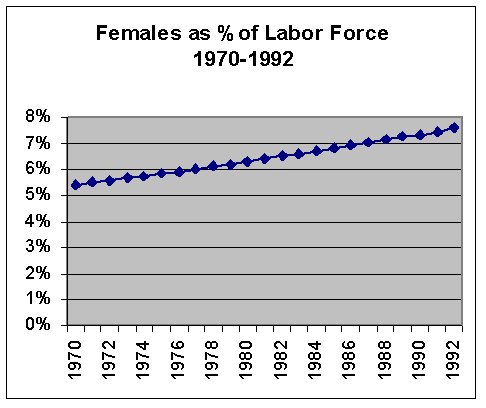
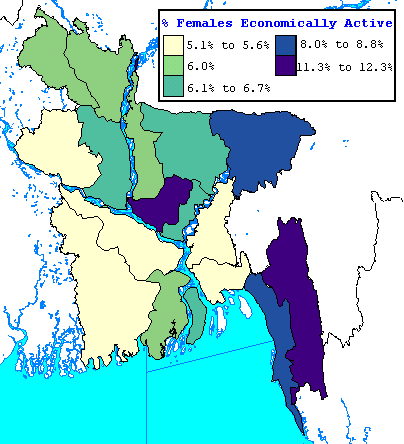
Exhibit 35 - Percent
Females Literate
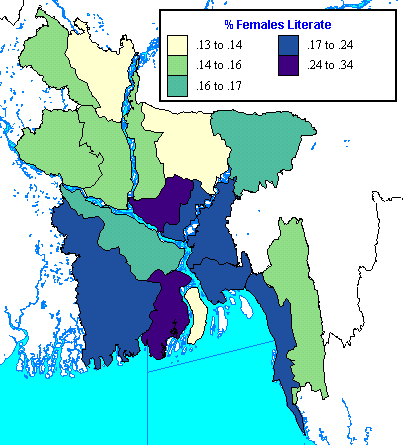
Exhibit 36 - Infant Mortality Rate
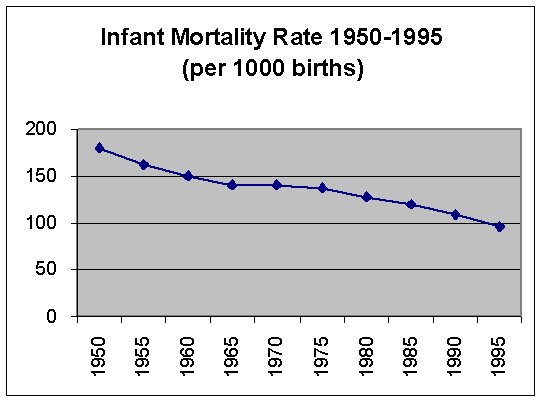
Disease: Disease increases fertility because it is a critical barrier to rising out of poverty, which is itself a contributor to fertility. Also, high rates of infant mortality raise fertility as women have more children to compensate for the high potential for loss. The Grameen Bank helps reduce the incidence of disease through its healthcare and housing loan programs.
Exhibit 37 - Urban
Population
Exhibit 38 - Rural Child/Woman
Ratio Exhibit 39 - Urban Child/Woman
Ratio
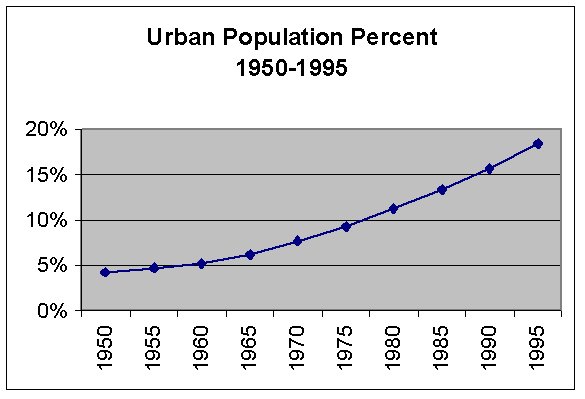
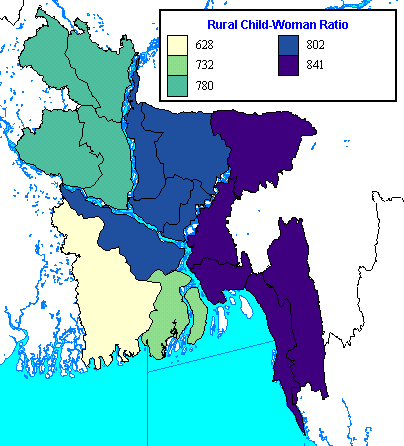
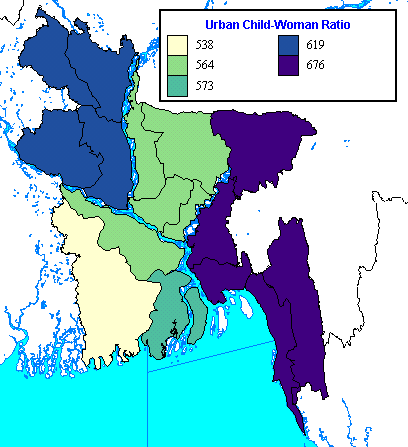
Urbanization: Urbanization by itself does not impact fertility, but an urban setting gives women more access to education, contraception, and employment. Also, child labor is not as valuable away from the agricultural work of rural Bangladesh. The exhibits above show the differences in the ratio of children to women between rural and urban areas. Bangladesh is steadily urbanizing, but the Grameen Bank works to stop the migration of the rural poor by giving them the resources they need to build their incomes in their home villages. For this one factor, Grameen may be increasing fertility by keeping people in rural settings.
Social Collateral: Women sometimes fear that if they become pregnant, they will not be approved for a loan by the members of her Grameen group. There is no official policy that punishes those who have additional children, but the fear of having loans withheld is enough to make some women delay having another child.
Access to Contraception: The use of contraception in rural areas has grown dramatically through government sponsored family planning programs and other NGO programs. Grameen does not include family planning and contraception in its programs, but it may increase access to contraception simply by given women opportunities to communicate with others outside their home and immediate family. The assertiveness they develop through Grameen gives them the confidence to seek out and speak with family planning providers.
Exhibit 40 - Births by Age Group
Exhibit 41 - Age Pyramid
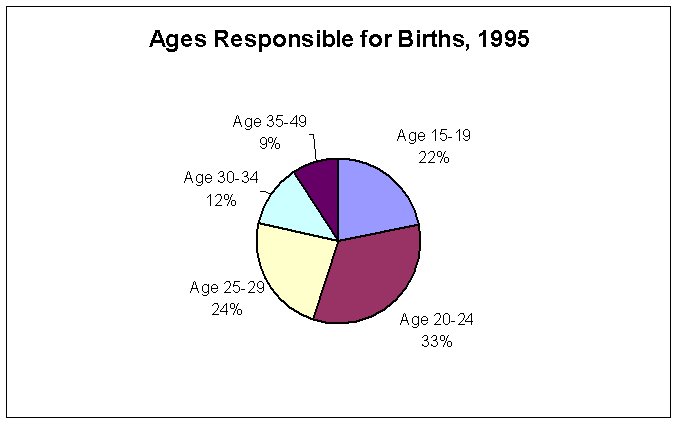

Distance Between Generations: Marriage is nearly universal for Bangladeshi women and occurs early in life, typically between the ages of 13 and 16. Women who marry at a young age start bearing children sooner and have more children over the course of their life. Over half of all Bangladeshi children are born to mothers less than 24 years old. Bearing children while young creates less distance between generations, accelerating the trend of population growth if subsequent generations also have children early in life. The age pyramid in the exhibit above illustrates the "pyramid" pattern of ages found in many developing countries with low life expectancies and high birth rates. The average age of marriage has increased slightly over time. It is not clear whether Grameen is having an impact on the distance between generations. It is possible that enhanced economic security and status of women could make mothers feel less concerned about marrying off their daughters soon.
Exhibit 42 - Percent Less Than Four Years Old
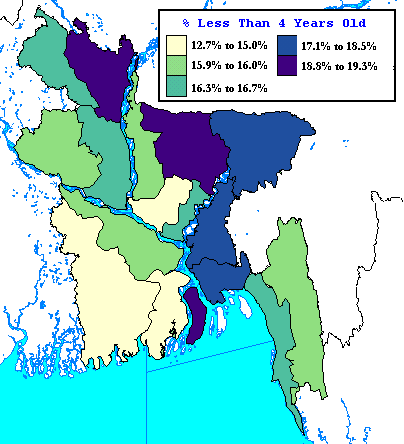
The exhibit above shows the percent of the population in each zone that is less than four years old. In the absence of regional fertility statistics, age distribution data can act as a proxy because a population with a higher fertility rate will have more small children per capita.
Exhibit 43 - Linear Regression
The exhibit above contains the results of a linear regression showing the contribution that four factors have on the percent of the population under four. This regression was performed with data from the Grameen Data Spreadsheet file, which contains statistics by zila. A zila is a small area, and Grameen defines its zones as a collection of zilas. The four factors tested are: % of females economically active, % of females literate, % Muslim, and % Urban. It should be noted that the regression was not very conclusive and that many factors could not be included due to lack of data. Most of the results of the regression weakly agree with our expectations that all factors would lower fertility except "% Muslim", which would raise it.
One conclusion that does seems clear is that female literacy has a clear relationship to the percent under four. The three zones with the highest fertility are also the three zones with the lowest percent of literate women. (Rangpur, Mymensing, and Bhola) The three zones with the lowest fertility are among the most literate zones for women.
Other factors still contribute to fertility rates, however. The other zones with high fertility (Sylhet, Comilla, and Noakhali), have reasonably high literacy rates for women. These three are all very rural. Two of these zones (Comilla and Noakhali) are strongly Muslim and have few of their women working. Sylhet is known as Bangladesh's most conservative area, and Grameen has struggled with religious fundamentalists over its activities. (Bornstein, 1996)